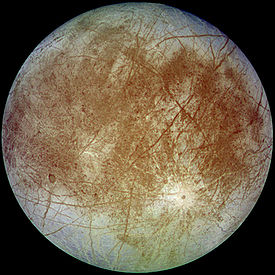Jupiter Week: Friday: Europa sounds eerily familiar
November 19, 2010
Jupiter has been taunting, bright in middle of the southern sky for—what? months now?—from our latitude. Only the moon and Venus can hold a candle to its magnitude, and Venus is off being coy somewhere below the horizon. So there is a bold Jovian dot up there, and we’ve been pointing David’s telescope at it. And trying to attach cameras to it. With mixed success.
In honor of our feeble attempts, here is Jupiter week! Each day a little snippet of astronomical wonder about the biggest planet we’ve got.
Friday: Europa sounds eerily familiar

Europa looks a bit stripey, but it's all relative: really, she's as smooth as cue ball. (Source: Wikipedia)
Silicate composition. Probably an iron core. A vast ocean, quite possibly of liquid water. An atmosphere rich in oxygen. Evidence of plate tectonics.
Europa, the smallest of Jupiter’s Galilean Moons, sounds a bit familiar, doesn’t it? This familiar, terrestrial-sounding setup is what cements Europa’s stature with scientists as a compelling, mysterious world that potentially harbors extraterrestrial life.
How to figure out if there really is living, breathing, farting, barking or zygotic life on Europa is still in serious artist’s conception phase and involves ideas like throwing stuff really hard at the planetoid’s icy, striated surface to see what happens. Or drilling a hole through the ice and peering around. With cryobots and hydrobots. No word yet on photon torpedoes.
For now, Europa is keeping her secrets to herself, sealing them within her icy cloak. What we can see from the outside are lineae and lenticulae (Latin for lines and freckles, respectively; our lady is no spring chicken), enigmatic patterns and cracks in the surface ice. Europa retains her appealing mystery even with what’s clearly visible: there’s no clear consensus about what causes either of these features.
Recently Reviewed
Get the Books
Read my Reviews
Related Posts
- Jupiter Week: Tuesday: That’s some velocity, little moon
November 16, 2010 - Jupiter Week: Wednesday: Delinquent moons
November 17, 2010 - Jupiter Week: Monday: Anthropomorphic Moons
November 15, 2010 - Jupiter Week: Thursday: Io, the little pustule of the sky
November 18, 2010 - Planets Everywhere: Building our model solar system
April 1, 2010



